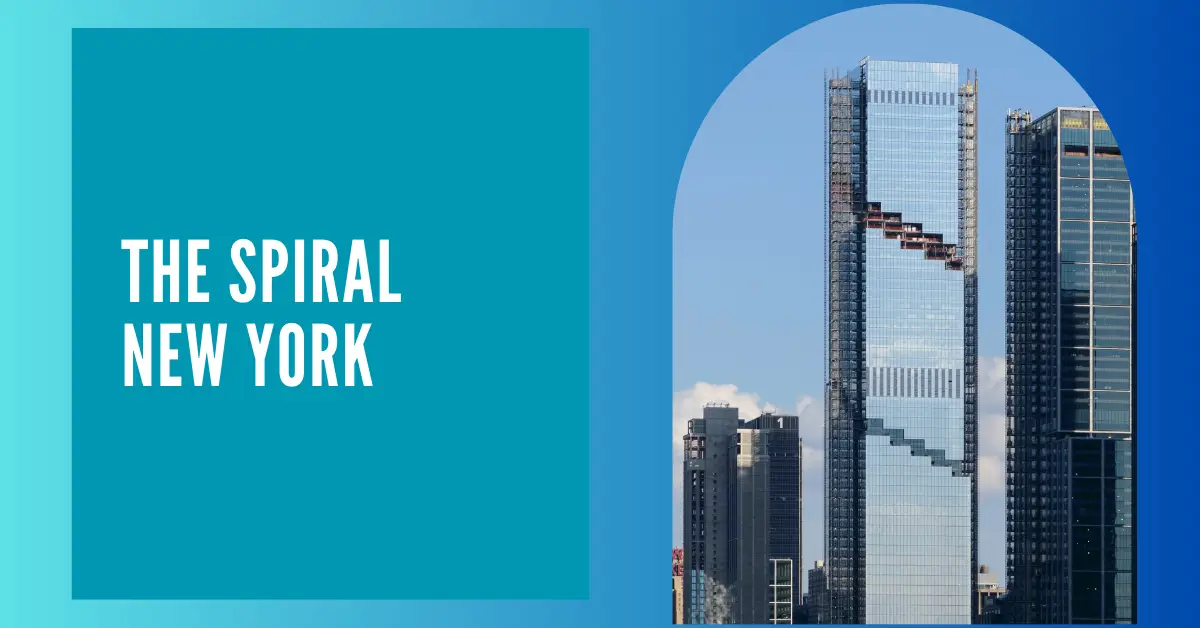New York City is a playground for skyscraper enthusiasts, with its skyline constantly evolving. Among the newest architectural wonders is The Spiral, a striking addition to Hudson Yards that redefines how we think about urban design and sustainability. Completed in 2023, this 66-story skyscraper is not just tall—it’s a green oasis in the sky.
Quick Facts About The Spiral:
- Height: 1,041 feet (317 meters), making it one of the tallest buildings in New York City.
- Location: Hudson Yards, Manhattan.
- Architects: Designed by the internationally acclaimed firm Bjarke Ingels Group (BIG).
- Purpose: A mixed-use building, primarily serving as office space, with retail and public areas.
Over view of The Spiral (New York City):
| Category | Details |
|---|---|
| Name | The Spiral |
| Former Names | Hudson Spire, 509 West 34th Street |
| Status | Completed |
| Type | Commercial |
| Architectural Style | Postmodern |
| Location | 66 Hudson Boulevard, Manhattan, New York |
| Coordinates | 40°45′19″N 73°59′58″W |
| Construction Started | 2018 |
| Topped-Out | January 2021 |
| Opened | 2023 |
| Height | 1,031 feet (314 m) |
| Floor Count | 66 |
| Floor Area | 2,850,000 square feet (265,000 m²) |
| Architect(s) | Bjarke Ingels Group |
| Developer | Tishman Speyer |
| Main Contractor | Turner Construction |
| Website | www.thespiralny.com |
Source: Wikipedia
Key Features
- Designed with outdoor gardens spiraling around the facade to create a continuous green pathway.
- Includes a clubhouse and an open-air terrace with panoramic city views on the 66th floor.
- Features an irrigation system by Bosch, saving 4.5 million gallons of water annually.
History
- Initially conceptualized in 2014 as Hudson Spire, with plans for a taller structure.
- Tishman Speyer acquired the site for $438 million and resolved tenant disputes in 2015 for $25 million.
- Plans were officially filed in September 2016.
- Received a $1.8 billion construction loan in 2018 from Blackstone Inc.
- Topped out in January 2021 and opened in 2023.
- Won the CoStar Impact Award for best commercial development in 2023.
Tenants
| Floor(s) | Tenant |
|---|---|
| Floor 2 | NewYork-Presbyterian Hospital – Och Spine Center |
| Floors 3–5 | HSBC |
| Floors 7–21 | Pfizer |
| Floor 22 | Baker Tilly |
| Floor 23 | NCC-group PLC |
| Floors 25–28 | AllianceBernstein |
| Floor 28 | ProShares, SEB Group |
| Floors 32–33 | Marshall Wace |
| Floors 35–36 | Turner Construction |
| Floors 40–52 | Debevoise & Plimpton |
Additional Information
- Includes a restaurant operated by Erik Ramirez and Juan Correa, known for Llama San and Llama Inn.
- The building’s design and construction reflect modern sustainability practices and innovative architecture.
A Unique Design Inspired by Nature
What makes The Spiral truly stand out is its distinctive design. The building features a cascading series of terraces that wrap around the structure like a spiral, creating a continuous ribbon of greenery. These terraces are planted with lush vegetation, giving the skyscraper a unique, natural appearance. This design isn’t just for aesthetics—it’s a practical solution for integrating green spaces into urban environments.
The terraces provide access to outdoor spaces on every floor, offering tenants fresh air and a connection to nature in the heart of a bustling city. For skyscraper enthusiasts, The Spiral is a perfect example of how modern architecture can blend functionality, beauty, and sustainability.
Sustainability at Its Core
The Spiral is more than just a beautiful building—it’s a sustainability powerhouse. The design incorporates energy-efficient systems, natural ventilation, and rainwater collection to minimize its environmental impact. The cascading terraces also help reduce the urban heat island effect by introducing greenery to the concrete-heavy skyline.
For those passionate about eco-friendly architecture, The Spiral stands as a shining example of how skyscrapers can contribute to a greener future. It’s a bold step forward, demonstrating that buildings can be both towering giants and stewards of the environment.
How The Spiral Compares to Other NYC Skyscrapers
While The Spiral is one of the tallest buildings in New York, its focus on green design sets it apart from other iconic skyscrapers. Here’s how it stacks up against some of the city’s most famous towers:
- The New York Times Building: Both buildings prioritize sustainability, but The Spiral takes it a step further with its cascading terraces and integration of green spaces.
- One World Trade Center: While One World Trade Center is taller and symbolizes resilience, The Spiral focuses on innovation in urban greenery and tenant well-being.
- Empire State Building: The Empire State Building represents the Art Deco era, while The Spiral embodies the future of sustainable skyscraper design.
Why Skyscraper Enthusiasts Love The Spiral
For fans of skyscrapers, The Spiral is a breath of fresh air—literally. Its innovative design, focus on sustainability, and commitment to integrating nature into the urban landscape make it a standout addition to New York City’s skyline. Whether you’re admiring it from afar or exploring its terraces, The Spiral is a testament to how architecture can evolve to meet the challenges of the future.
Final Thoughts
The Spiral is more than just another tall building in Manhattan—it’s a statement about the future of urban living. Its combination of cutting-edge design, environmental responsibility, and tenant-focused features makes it one of the most exciting additions to New York City’s skyline in recent years. For skyscraper enthusiasts, it’s a must-see and a symbol of how architecture can innovate while staying connected to nature.

